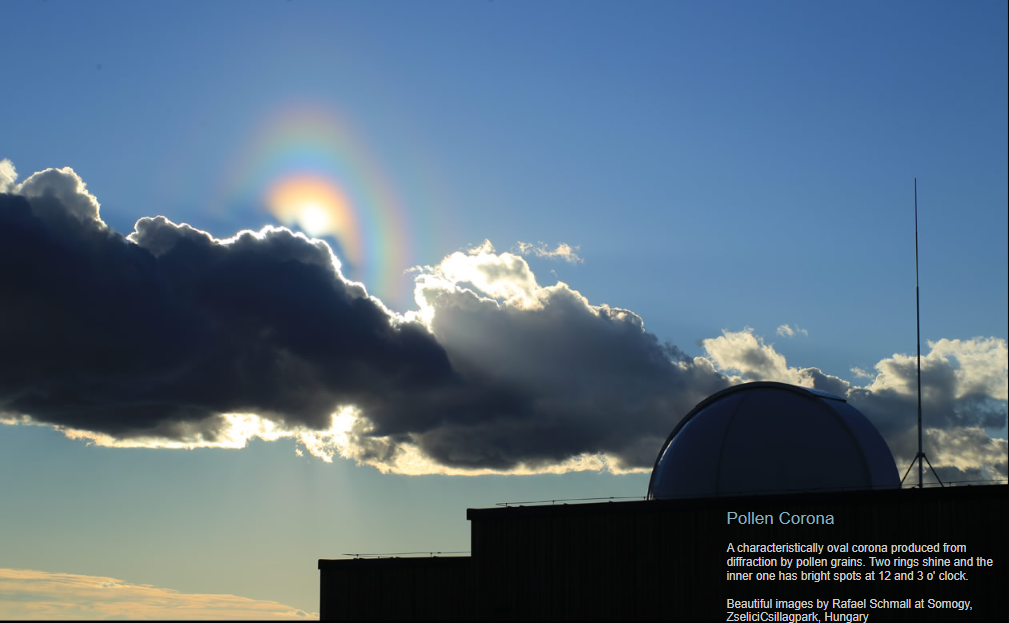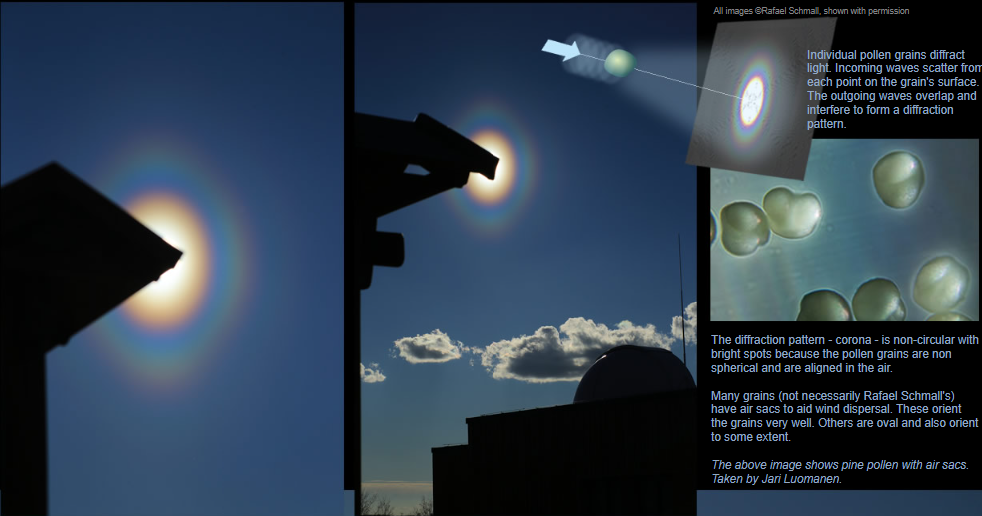Pollen Corona, Hungary - OPOD
Pollen Corona: A Stunning Display of Atmospheric Optics in Hungary
When it comes to atmospheric optics, one phenomenon that captivates both scientists and nature enthusiasts alike is the pollen corona. These captivating oval coronas, produced from the diffraction of light by pollen grains, create a mesmerizing display in the skies above Hungary. In this article, we will explore the intricacies of the pollen corona, its formation, and the factors that contribute to its unique appearance.
The Science Behind the Pollen Corona
At the heart of the pollen corona's enchanting beauty lies the diffraction of light by individual pollen grains. As light waves interact with each point on the surface of a pollen grain, they scatter in different directions. The outgoing waves then overlap and interfere with each other, giving rise to a distinct diffraction pattern known as the corona. Unlike circular coronas, the pollen corona takes on an oval shape due to the non-spherical nature of the pollen grains themselves.
Factors Influencing the Pollen Corona's Appearance
Several factors contribute to the specific characteristics of the pollen corona. One such factor is the alignment of the pollen grains in the air. As they float through the atmosphere, these grains tend to align themselves, further enhancing the distinct shape of the corona. Additionally, some pollen grains possess air sacs that aid in their wind dispersal. These air sacs play a role in orienting the grains and contribute to the overall appearance of the corona.
Mesmerizing Images from Hungary
Renowned photographer Rafael Schmall has captured stunning images of the pollen corona in Hungary, specifically at Somogy, ZseliciCsillagpark. These images showcase the intricate details of the corona, with two rings shining and a set of bright spots located at 12 and 3 o'clock. Schmall's photographs provide a visual feast for those fascinated by atmospheric optics, allowing us to appreciate the beauty and complexity of this natural phenomenon.
Beyond Hungary: Variations in Pollen Corona Appearance
While the images captured in Hungary are a testament to the captivating nature of the pollen corona, it is worth noting that the appearance of the corona can vary depending on various factors. Different types of pollen grains, each with their unique characteristics, can contribute to variations in the corona's appearance. Factors such as shape, size, and orientation of the grains all play a role in shaping the diffraction pattern and the resulting corona.
Exploring the Diversity of Pollen Grains
Pollen grains come in a wide array of shapes and sizes. While some grains are oval and possess air sacs, others may have different structural features. These variations in grain morphology can lead to diverse diffraction patterns and coronas. Exploring the microscopic world of pollen grains reveals a fascinating realm where nature's intricacies are on full display.
The Fascination of Atmospheric Optics
The study of atmospheric optics offers a captivating glimpse into the wonders of our natural world. From rainbows to halos and everything in between, these optical phenomena never fail to amaze us. The pollen corona, with its unique oval shape and bright spots, adds another layer of intrigue to the already mesmerizing field of atmospheric optics. By delving deeper into the science behind these phenomena and appreciating the artistry captured by photographers like Rafael Schmall, we can gain a greater understanding and appreciation for the beauty that surrounds us.
In conclusion, the pollen corona is a breathtaking display of atmospheric optics found in Hungary. Its oval shape, created through the diffraction of light by pollen grains, sets it apart from other coronas. Factors such as grain alignment and morphology contribute to the corona's unique appearance. Through the lens of photographers like Rafael Schmall, we are granted a glimpse into the captivating beauty of this natural phenomenon. As we continue to explore the world of atmospheric optics, the pollen corona serves as a reminder of the enchanting wonders that await us in the skies above.

Pollen Corona
A characteristically oval corona produced from diffraction by pollen grains. Two rings shine and the inner one has bright spots at 12 and 3 o' clock.
Beautiful images by Rafael Schmall at Somogy, ZseliciCsillagpark, Hungary
All images ©Rafael Schmall, shown with permission

Individual pollen grains diffract light. Incoming waves scatter from each point on the grain's surface. The outgoing waves overlap and interfere to form a diffraction pattern.
The diffraction pattern - corona - is non-circular with bright spots because the pollen grains are non spherical and are aligned in the air.
Many grains (not necessarily Rafael Schmall's) have air sacs to aid wind dispersal. These orient the grains very well. Others are oval and also orient to some extent.
The above image shows pine pollen with air sacs. Taken by Jari Luomanen.


Note: this article has been automatically converted from the old site and may not appear as intended. You can find the original article here.
Reference Atmospheric Optics
If you use any of the definitions, information, or data presented on Atmospheric Optics, please copy the link or reference below to properly credit us as the reference source. Thank you!
-
<a href="https://atoptics.co.uk/blog/pollen-corona-hungary-opod/">Pollen Corona, Hungary - OPOD</a>
-
"Pollen Corona, Hungary - OPOD". Atmospheric Optics. Accessed on November 26, 2024. https://atoptics.co.uk/blog/pollen-corona-hungary-opod/.
-
"Pollen Corona, Hungary - OPOD". Atmospheric Optics, https://atoptics.co.uk/blog/pollen-corona-hungary-opod/. Accessed 26 November, 2024
-
Pollen Corona, Hungary - OPOD. Atmospheric Optics. Retrieved from https://atoptics.co.uk/blog/pollen-corona-hungary-opod/.